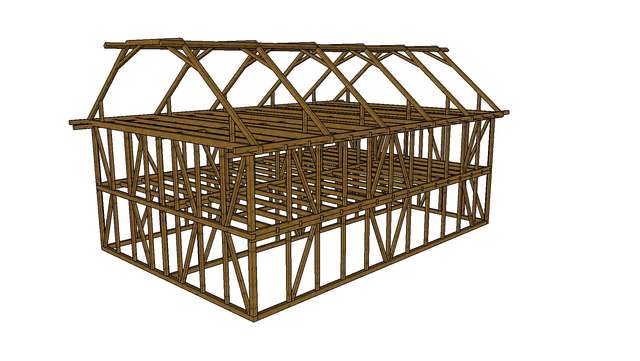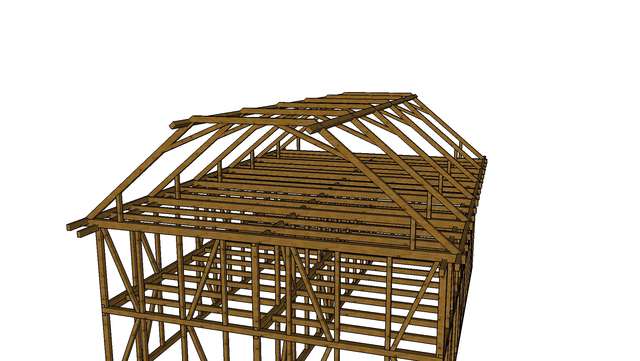I talk a lot about Swiss Timber frames, obviously it is my passion and area of study. I'm very fond of the sorts of techniques and solutions that this culture developed over the centuries. I find the methods they use to be unique and ingenious.
It occurs to me that with so much talking, I have done a poor job of actually sharing useful images and illustrations. I have a number of models, so I thought I'd share some of the different techniques with you here.
So i'll share some images I've created so you can have a better look at some of the details. First I'll post up images of a few different style, then I will step back and discuss a bit of what's going on.
First is the 'modern' (we'll get into that later) style of light timber construction. You might recognize this as essentially the same style of framing used in German half-timbered buildings(Fachwerk) of later (post 16th century in most cases) construction, but it is not necessarily a half-timber construction method. In Switzerland it is often used in situations where it is meant to be clad over or concealed, although it is also seen in half-timbered construction as well. When viewed as a framing method, the Swiss call this 'Riegelbau' and the Germans have a variety of terms such as 'Geschossbau'. Fachwerk refers in both cultures to half-timbered construction in general.




This is a very very basic illustration lacking any framing for doors and windows, and only showing a single partition necessary for supporting the middle of the cross beams (this building is 30x40 feet).
The Roof structure is a simple 'Liegender stuhl' system, here shown without the common rafters which would be bound together at the peak and fastened to the purlins without a birdsmouth of other such joint, and extend past the lower purlins several feet.
Corner posts are larger, here 6x6, with the inside corner removed. The posts located where two walls intersect are also larger, here 5x6, and have both resulting inside corners cut out. All other posts are small, here 4x4 which is more or less the typical size (old examples use whatever local standard inch existed at the time, and anything built in the last 150 years or so uses metric, so measuring timbers with an american rule is not likely to give you a nice clean number)
The different levels of the structure -ground floor, first floor, and roof structure- are all essentially separate frames stacked atop each other. The method of capturing the cross beams between two timbers (using a special joint called in German Kamm or comb, which is basically a category of cog joints) creates a very sturdy structure without the need for tall posts extending the entire height of the structure.
Here long braces are used, which became the standard practice throughout the broad region where this style of framing is practiced probably in the 17th century, maybe a little later. These braces do not join to the posts at all, since the smaller posts can not afford to have joinery cut into them without sacrificing their strength. In theory, such bracing is less efficient that corner bracing since it does not create true triangles, but in practice it is more than sufficient.
It is not uncommon to see this executed a little differently, where instead of employing timber specifically for the purpose of bracing, one of the posts is inserted at a slight angle.
These braces must be matched to work -a brace leaning one direction must be matched by a second brace leaning the other direction, or else it may actively push the building over! When set in pairs, these braces rely on the weight of the building to keep things square -in order to shift against the brace, it would have to stand upright, pushing the plate above it upward. The weight of the structure and the pegs joining the posts to the plate prevent this from happening.
THe connection on the gable side between the two stories shown here is the most common, but not the only way it can be done. You can also some times see where there is a separate top plate and sill joined at the same levels as those on the eaves sides, often reinforced with a steel or iron strap.
This style of building originates in urban framing methods of the late Middle Ages. There is a lot of debate as to when, where, and why this happened. It's likely this style originated somewhere on the western part of the Swiss Plateau, either in Germany or Switzerland, some time around the year 1500. I believe it to have been developed as an inexpensive and practical way to construct homes in the poorer sections of the old stone cities such as Bern and Basel. That being the case, this would have originated as a half-timbered style of construction -but was quite a bit different than the other half timbering styles already in existence.
I am most impressed by the adaptations of this style to rural construction that happened a few centuries later. This is the style that was adopted as industry and technology spread out on the Swiss Plateau and beyond, because it is so well suited to a more industrial means of producing timbers from trees and converting them into frames.
I also believe this style to have had precursors in the rural building styles that existed along the southern edges of the Plateau prior to its invention. Most of the elements that define this style as something new and unique are to be found in other, older styles that have nothing to do with the half timbering traditions of the cities to the north. These include the platform framing concept and the way it is accomplished, and the way the frame is tied together horizontally.
We'll look at those styles of framing next.
I am quite fond of this style of framing. I believe it to be one of the most ingenious and practical methods of framing ever developed, and very well suited for carpenters working with modern design requirements, modern conversion processes, and who rely on transporting things over a great distance (these are the primary reasons it replaced the older methods in Switzerland). If I were building for pure practicality, this is the method I would use. It's also very well suited to prefabrication -some all-wood adaptations of the style used in Switzerland today assemble entire wall sections in the shop and ship them to the job site ready to be placed by a crane. A entire large house can be set in place in a day.